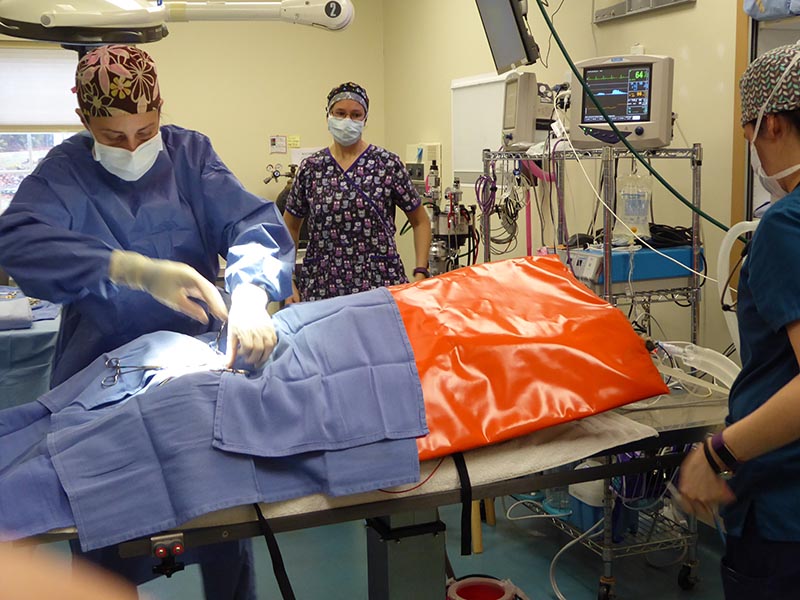How does body heat loss occur upon induction of general anesthesia? Virtually all anesthetic induction medications widen the blood vessels or are vasodilators. Upon anesthetic induction, there is widening or vasodilation of the peripheral blood vessels in the skin, legs, and tail. Consequently, there is shunting of warm core blood from the abdomen and chest to the dilated peripheral blood vessels, the patient literally becomes a heat radiator from the skin, legs, and tail.
Hypothermia is a challenge in every operating room and is defined in dogs and cats as follows:
- Mild hypothermia: 98 to 99.9 F
- Moderate hypothermia: 96 to 98 F
- Severe hypothermia: 92 to 96 F
- Critical hypothermia: 92 F or less
The patient now loses body heat by the four mechanisms of body heat loss:
-
Radiation: This is the primary cause of heat loss in the operating room. Radiation refers to the transfer of body heat in the form of infrared radiant energy to cold objects not in contact with the patient’s body, such as the walls of a cold operating room.
-
Conduction: This is the loss of body heat from objects in direct contact with the patient’s body, such as the operating table.
-
Convection: This heat loss occurs from the physical movement of ambient air around the patient’s body such as the cold air in the operating room.
- Evaporation: Warmed moisture on the patient’s body is lost from the application of prep solutions such as alcohol or betadine. Body heat is taken as the solutions evaporate.
If no preventive measures are taken in the next 30 to 60 minutes, the patient will lose 81% of the body heat that it will potentially lose during the course of that anesthetic.
Quick takeaway: Anesthetic induction is the most important time to prevent body heat loss.
Therefore, it is critical to take preventive heat loss measures during anesthetic induction to prevent dangerous body temperature levels. Preventive patient warming solutions include warming pads, thermal blankets, and temperature monitoring systems:
-
HoverHeat Warming Pads: Previously forced-air warming over the patient was the primary method of patient warming. It involved the placement of a disposable blanket over the patient with a warm air blower providing warm air through its air channels. This method allows only a small surface area of the patient to be warmed. The innovative HoverHeat Warming Pad now levitates the patient to provide for low resistance warm airflow underneath the entire body of the patient. It accommodates any warm air blower that you may have and increases its warming capacity by 50 to 75 percent.
The award-winning HoverHeat product line is widely used in veterinary clinics across the country for pre-op, intra-op, and post-op warming needs and is compatible with any warm air blower.
Browse VetORSolutions Warming Pads
-
ConRad Thermal Blankets: The ConRad Thermal blankets act as a barrier to conductive, convective, and radiant heat loss. They are designed for use during anesthetic induction, preop prep, surgery and post-op recovery to maintain patient normothermia. Remember, 81 percent of the heat loss that the patient will ultimately lose during the course of that anesthetic occurs during the first 30 to 60 minutes after anesthetic induction. Use the ConRad Thermal Blankets to prevent this heat loss. ConRad Thermal Blankets are available for General Use and MRI.
Browse VetORSolutions Thermal Blankets
- Temperature Monitoring Systems: Accurate patient temperature monitoring is imperative in providing hypothermia interventions. Remember, that which is not monitored cannot be managed. Learn more about temperature monitoring tools in How digital monitoring can quickly alert to thermal changes during surgery, in Veterinary Practice News.
Contact us to learn how VetORSolutions warming systems can help to optimize patient body temperature during surgical and imaging procedures.

